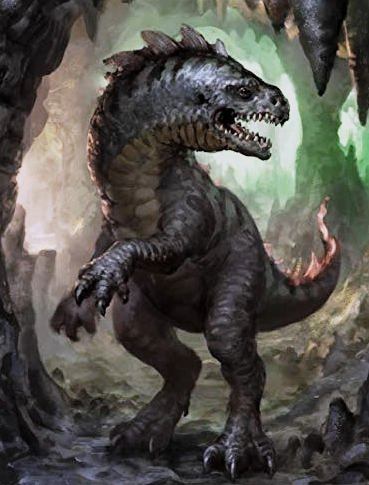Bonesnapper
| Species | therapid (ossis frangereturus) |
| No. Appearing | 2–5 |
| Behaviour | social |
| Range | savanna, subterranean |
| Size | 23 ft. long |
| Weight | 1,200 lbs. |
| Intelligence | 1 |
| Armour Class | 5 |
| Hit Dice | 8 |
| Action Points | 4 |
| Max. Stride | 10 |
| THAC0 | 16 |
| Hp/Die | d4+d6 |
| Attack Forms | 1: fangs |
| Damage | 3–24 (fangs) |
| Special Attacks | none |
Bonesnappers are lightly-built bipedal reptiles, with a long tail and massive head. Their hind limbs are strong and likely used for balance; the forelimbs arn't used for fighting. These creatures are rarely found alone; they tend to be in the company of another of their kind, often a female and offspring.
Contents
Offspring stay with the parents into adulthood, until encountering another family group. This happens during the dry season, as the creatures begin to congregate at reliable waterholes. Groups mingle and the female approaches males according to their skin colouration and a "dance" that's part of the mating ritual. Pairs move off independently to form new groups. Lone males — who steadily grow increasingly aggressive for several months until becoming dangerously rabid; during this period, the early wet season, bonesnappers may launch vicious attacks until they are killed or are discovered stumbling delusionally in circular patterns.
Hunting
Bonesnappers are voracious eaters. Leading up to the dry season, they hunt larger animals in packs — especially lone elephants or rhinoceroses. They've been known to bypass smaller, less meaty prey like humanoids, whom they prefer to hunt when there are children to be fed. Bonesnappers loll during the daylight hours when it's hot and prefer to hunt three or four hours in the evening, until the light has diminished. They sleep together in a close pile. They may hunt briefly in the morning.
Guardians
The creature's habit of bypassing humans, and especially children, as prey — while in fact saving a villager by striking at a stalking lion, has encouraged a belief that the bonesnappers are in fact tribal "guardians," though it remains a fact that these creatures cannot be approached lightly. Nonetheless, many African witnesses have seen like things.
Further, because of changes in the bonesnapper's behaviour as the wet season approaches, there are rituals designed to make the creatures "go mad" in the hopes that this will bring rain.
See Bestiary
